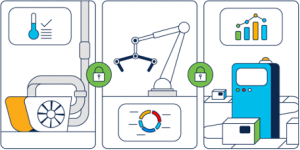After digitizing their operations, today’s factories are poised to take the next step in modernizing their plants. They are investing in advancements that use software to control and automate manufacturing processes from design to production. This software-driven approach consists of using analytics aided by AI/ML technologies to analyze operations data, draw insights, and provide feedback to control systems for more efficient and flexible production processes.
Manufacturers are investing in new software capabilities that include:
- Analyzing real-time data gathered from production systems to detect equipment errors, malfunctions, and predictive and proactive maintenance needs
- Using “digital twins” to represent a product from its design, production, and performance when deployed that optimizes the product and production system before investing in physical prototypes and building assembly lines
- Virtualizing traditional hardware Programmable Logic Controllers (PLCs) to software ones for easier updates and real-time control
These new capabilities allow manufacturers to quickly respond to changes in demand, improve production efficiency, reduce costs, enhance innovation, and improve product quality. Another key benefit is the ability to quickly pivot to new products and respond to changes in the marketplace by enabling production of smaller batches of products with greater speed and flexibility.
How factories can prepare

But before manufacturers make efficient use of these technological advances, they’ll need to overcome significant hurdles. In addition to the challenge of integrating virtualized PLCs and cloud applications with their production systems, they need to ensure that their infrastructure is up to these demanding requirements.
- Reliable network connectivity: A software-centric approach requires a high degree of dependable network connectivity between machines, robots, and other devices in the production process. This means that factories will need to invest in advanced networking infrastructure, including high-speed and resilient Ethernet connections as well as wireless networks, to ensure seamless communication between devices, controllers, and the new software systems.
- Alignment between IT and OT teams: A software-centric approach requires that information technology (IT) and operational technology (OT) teams pool their skills and resources to build a network optimized for manufacturing operations. This requires factories to introduce more IT tools that can automate networking functions, assure performance, and put in place security policies, giving OT teams the freedom to operate the production network within the established guidelines.
- Machine-to-cloud connectivity: Many software-centric approaches rely on cloud-based applications. This means that factories will need to build networking capabilities that would let them adopt cloud-based solutions in a secure and efficient manner that can handle large volumes of data and provide real-time analytics to support decision-making.
- End-to-end security: Because software-centric approaches require a high degree of network connectivity and integration between IT and OT systems, it can increase the risk of cyber-attacks. Factories will need to implement robust cybersecurity measures to contain the blast radius beyond just implementing an industrial demilitarized zone (IDMZ), like improved visibility and microsegmentation to protect their networks, devices, applications, and data from malicious actors.
- Edge computing: Software-centric methods can benefit from edge computing that processes data locally rather than sending it to an enterprise data center or cloud, to help reduce network traffic & latency, improve performance, increase reliability, and boost security. Factories should invest in edge-compute capable networking equipment as these are closest to data sources.
How Cisco can help

Since Cisco introduced its first ruggedized switch twenty years ago, its portfolio has grown to include modern switches, routers, and wireless equipment with built-in security and capabilities that are purpose-built for industrial and manufacturing operations. These products leverage the best of networking technology from their enterprise counterparts with their scale, agility, and performance. They are managed and secured by the same set of tools, which fosters collaboration between the organization’s IT and OT personnel. Moreover, Cisco equipment allows you to develop and run applications within its networking equipment eliminating the need for complex and costly external servers. Comprehensive architectural solutions, tested and documented in Cisco Validated Design guides, provide a reference to building secure and scalable modern factory networks. Learn more at Cisco IoT solutions.
Visit us at Hannover Messe 2023

Cisco will be demonstrating how our solutions can help solve your challenges and put you on a path to smarter manufacturing. Register to visit us in Hall 015 Stand F18 at Hannover Messe being held between 17 and 21 April 2023, in Hannover Germany, or schedule an one-on-one manufacturing demo today with one of our experts.
Get started with a few additional links below:
Cisco Portfolio Explorer for Manufacturing
Great way to recap on the must 5s Vivek! Worth reading
Great Blog, Thanks for sharing.
Amazing #CiscoLovers #CiscoExperience